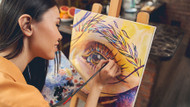Posted by Kris Allo on Aug 22nd 2025
Dreams and Art: A Bridge Between Worlds
Dreams have always fascinated us. More than fleeting images in the night, they’re messages from within. If we pay attention, they can connect us to hidden parts of ourselves, to our ancestors, and even to the greater mysteries of the universe.
When we bring our dreams into art, a dream that might dissolve upon waking can instead take form. Through colors, shapes, and perhaps symbols, it becomes a living expression of energy that allows us to see what usually stays invisible. Dream-inspired art connects us more deeply with our subconscious, our spirit, and even the collective energy we all share.
Across many cultures, dreams and art have been honored as powerful companions. In this article, we’ll explore how different traditions all over the world understand and work with dream-inspired art, and how you can engage with your own dreams in creative practice.
Indigenous Perspectives: Dreams as Living Spirit
Across Indigenous traditions worldwide, dreams are understood as sacred connections with land, ancestors, and spirit. For Australian Aboriginal peoples, Dreamtime is an eternal reality expressed through art, song, and ceremony. It keeps ancestral energy alive in the present. Native North American peoples often view dreams as guidance from ancestors or spirit guides, and bring it into form through arts like beadwork, pottery, or sand paintings. In South America, groups like the Shipibo-Conibo of Peru create intricate patterns from dream visions, embedding healing and spiritual knowledge into their art.
These Indigenous cultures, and many others, honor dreams as guides and healers. So, dream-inspired art sustains balance, cultural identity, and healing not just for the individual, but for the community as a whole.
African Traditions: Dreams as Guidance and Protection
In many African cultures, dreams are likewise sacred channels of communication with ancestors and spirit. They are woven into daily life, offering warnings, blessings, insights, and healing power.
Artists often translate dream images into carvings, textiles, masks, and ritual objects that embody protective and healing energies. These artworks are not only seen, but experienced as living presences, central to rituals and communal gatherings. In this way, they preserve memory, affirm identity, and help maintain harmony between the human and spiritual worlds.
Asian Views: Dreams as Metaphors for Awakening
In Buddhist and other Asian traditions, dreams are often seen as metaphors for the illusions of the mind. They remind us of impermanence, teaching us that waking life, too, is like a dream.
Artists in these traditions sometimes explore the dreamlike state not by painting literal dream images, but by making art that captures the liminal space between waking and sleeping. For example, Zen art often evokes the threshold between realities, inviting us into contemplation and spiritual insight.
Western Perspectives: Dreams as Gateways to the Subconscious
In Western psychology, dreams are often seen as doorways to the unconscious. Psychologist Carl Jung taught that dream figures and images carry archetypal energies, universal patterns that bring our attention to what’s unresolved or waiting to be integrated.
Jungian art therapy transforms dream symbols into visible form, helping us integrate the parts of ourselves we’ve pushed aside. A dream painted or drawn becomes a safe space to engage with hidden feelings and release them.
How to Work with Your Dreams Through Art
No matter the culture, dream-inspired art carries powerful energy bridging the seen and unseen worlds. Hidden feelings find safe expression. Images reveal patterns in our lives. Ancestral wisdom and collective memory become tangible. And the subconscious layers of our being get stirred into awareness.
You don’t need to be an artist to work with your dreams through art. Here’s a simple practice you can try:
- Keep a Dream Journal
Record your dreams as soon as you wake up. Don’t worry if they feel fuzzy. Symbols, feelings, or even single words can be enough to work with. - Choose One Image to Draw or Paint
It could be a figure, a place, or even just a color from your dream. Recreate it freely, without trying too hard, and without judgment. - Notice the Energy
Observe how your body feels as you draw or paint from your dreams. Does it bring relief… tension… curiosity? - Dialogue with Your Dream
When your artwork feels complete, take a few moments to sit in silence, and “listen.” Ask the image what it wants you to know. You can write down any insights that come. If nothing comes in the moment, trust that your subconscious is gathering insights that will be revealed when the time is right.
Dream Art as a Path to Wholeness
Dreams and art both speak the language of energy, symbol, and spirit. When combined, they become a bridge to our deeper selves.
Every dream carries energy waiting to be expressed, and every brushstroke, line, or color inspired by a dream is an invitation to healing and self-discovery.
So the next time you wake up with a dream lingering in your heart, try bringing it into form. You may find that what feels mysterious at night becomes a source of light and guidance in the day.
The Change Your Energy Art Gallery features works created to carry living energy. Explore the gallery here to connect with what lies beneath the surface.

